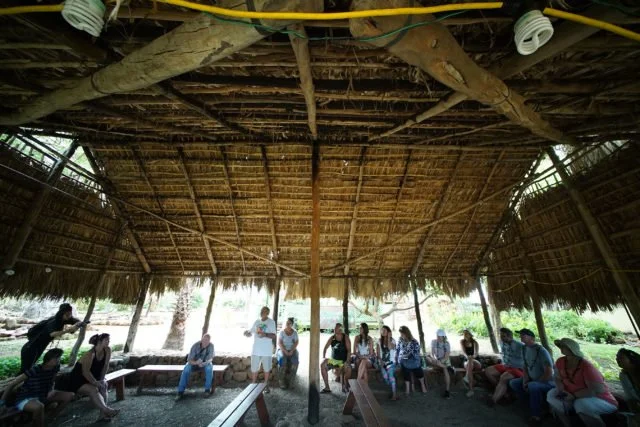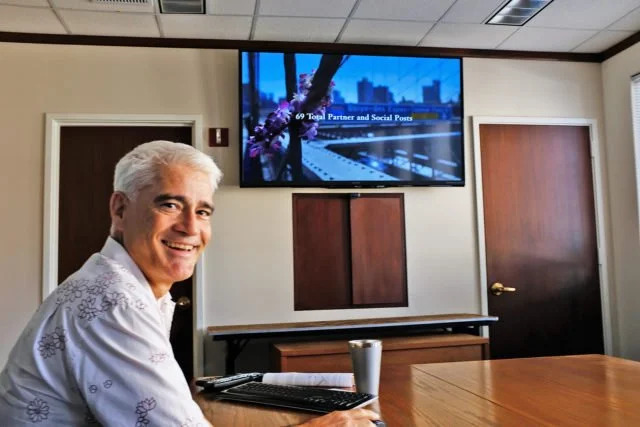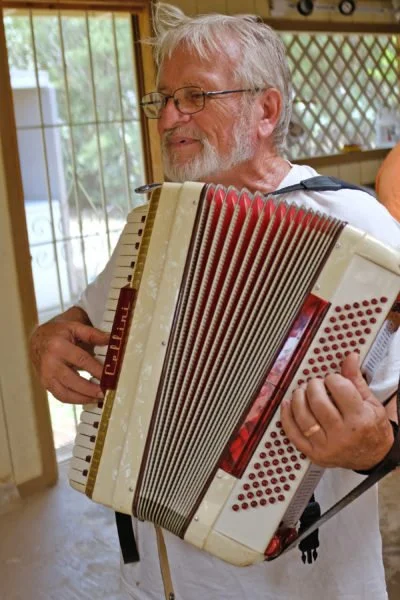Civil Beat: Could O‘ahu’s West Side Be The New Vacation Hot Spot For Millennials?
Luigi “Gigi” Cocquio from Hoa Aina O Makaha shares thoughts during a tour by travel journalists. The farm’s thatch-roof hut has burned down three times, he said.
The Hawaii Food & Wine Festival is promoting island agriculture by taking travel writers to the Leeward Coast. But will it sell?
June 2, 2017 | Original post at Civil Beat
By Stewart Yerton
On Tuesday at the Kahala Hotel & Resort, a group of travel writers boarded a white Cadillac Escalade and Black Mercedes SUV and, escorted by an entourage of hotel staff and publicists, rode west to an unlikely locale for those who typically write about luxe restaurants and resorts.
Out in Waianae, the writers toured a farm, talked to elementary school students, lunched on local produce and ended the outing with a ride on a Hawaiian sailing canoe.
Not your typical travel magazine junket for people who write for publications like Town & Country, Forbes and Marin Magazine, but that was exactly the point, said Tannya Joaquin, a former television news anchor who is now director of public relations for the Hawaii Food & Wine Festival.
Market research shows millennials – or people born roughly from 1980 to the late-1990s – want cultural experiences, Joaquin said.
The trip to the Leeward Coast hit several of the themes that the research shows young-adult travelers want: local cuisine, authentic culture and meaningful life experiences rather than simple entertainment.
The farm tour’s emcee was an accordion-playing former Catholic priest who had started the farm after being deported from the Philippines for opposing former President Ferdinand Marcos. The lunch was the culinary equivalent of a poi dog: Italian gnocchi, Filipino lumpia, Hawaiian poi, along with green beans, homemade chips, and vegetable lasagne served on paper plates.
The canoe ride launched from a spot next to Waianae’s large-scale homeless encampment.
It might have seemed a counterintuitive way to impress urbane literary types. But the outing made sense to Laura Begley Bloom, a travel brand strategist who writes for Forbes and other publications and participated in the tour.
“Millennials value experiences over things,” said Begley Bloom. “Now they are having kids, and they want their kids to have authentic experiences.”
Will journalists accustomed to writing about celebrity chefs and luxury resorts care to write about community-based agriculture in Waianae?
Not Just Sun, Surf And Sand
Tourism marketing executives have been working to focus on such travelers — not millennials as an age demographic, but as part of a group that shares certain values, said Jay Talwar, chief marketing officer for the Hawaii Visitors and Convention Bureau. The target group views life as a journey and traveling as “an enriching moment in the journey.”
The bureau’s research prompted a blitz this year in New York City, which has a concentration of Hawaii’s target travelers, Talwar said. The bureau wants them to know Hawaii isn’t just about sun, surf and sand, but that it’s a place with distinctive culture and cuisine.
Big-name chefs, he said, are the new rock stars.
The bureau’s research also shows that millennials value altruism, Talwar said.
“The ‘greed is good’ idea doesn’t resonate here,” he said, quoting a line from the movie, “Wall Street” that defined the Go-Go 1980s. “This is almost an echo of the Greatest Generation — who did things for the community, for the greater good.”
Jay Talwar, chief marketing officer for the Hawaii Visitors and Convention Bureau, says celebrity chefs are the new rock stars. Stewart Yerton/Civil Beat
And what could embody such values more than a trip to Hoa Aina O Makaha, a farm in the Makaha Valley that was started by Luigi “Gigi” Cocquio. As the story goes, after Cocquio, who was then a priest, was sent by the church to Waianae in 1979, he started cleaning up some church-owned property that contained two dilapidated Quonset huts and not much else.
Cocquio got help from Eric Enos, of Kaala Farm in Waianae, who along with others from the community cleared the land.
Over the decades, Cocquio dedicated his time to community projects while building Hoa Aina O Makaha. The farm now operates as a non-profit working with Makaha Elementary School; students cultivate small plots with a teacher’s guidance.
“How amazing would it be if tourists could see something like this?” — Laura Begley Bloom, travel brand strategist
So there was Cocquio on Tuesday, holding court with a handful of writers like Adam Robb of New York, whose recent work has included articles about a nightclub for “the new generation of Hollywood stars” and celebrity chef Wolfgang Puck’s new restaurant in West Hollywood.
Dressed in a T-shirt, cargo shorts and dusty, beat-up sandals, his face weathered from years in the sun, Cocquio was a stark contrast to one of Robb’s more recent profile subjects, a jewelry designer from Zimbabwe who once dated Harry, the Prince of Wales.
When Cocquio spoke, he still sounded like a priest, although he left the church years ago to marry and raise a family.
“When people come with a good heart and good spirit, the land rejoices,” he said.
Luigi “Gigi” Cocquio, founder of Hoa Tina O Makaha, said statistics alone do not tell the story of Waianae. Stewart Yerton/Civil Beat
Later, he acknowledged that the community faces challenges, including children who act up out of anger. The farm’s traditional hale has been burned down three times, its goat was once stolen and ice cream has been pilfered from the kitchen.
“The only thing you can do in those situations is to find those kids and give them a hug,” Cocquio said. “There is nothing else.”
Later he added: “Society breaks the legs of the people and after that blames them because they limp.”
Society has certainly given the west side some broken legs, or at least some facilities most areas don’t want. The municipal Waimanalo Gulch and private PVT landfills are there, as is the H-Power waste incinerator. Makua Valley for decades was a military firing range and site for combat simulations using live weapons; Native Hawaiians have had to fight repeated court battles for access to sacred sites in a place where hidden, unexploded ordnance still poses a risk of injury.
Almost 40 percent of children under 18 in Waianae live below the poverty level. Nearly 62 percent of residents have a high school degree or lower. The unemployment rate in 2015 was just under 14 percent, more than twice the statewide average of 6.1 percent.
To be sure, the valleys of west Oahu are beautiful: vast and fertile, bounded by cathedral-like mountains, emerald and azure waters. Figures carved into the stones attest to the presence of Native Hawaiians dating back centuries.
The landmark Kaala Farms perpetuates knowledge of traditional taro farming in Waianae. Even Michelle Obama has spent quality time there, participating in an hour-long panel discussion with young people at Ma’o Organic Farms.
The question is: Would any of the writers want to tell the area’s multi-layered story?
Chef Mark “Gooch” Noguchi, a graduate of the Culinary Institute of America who has worked for the Town and Chef Mavro restaurants in Honolulu, said it takes only one journalist to understand the full story and get the message out. Still, he added, it’s a complex story.
“It’s so much more than a hashtag,” Noguchi said.
Festival Benefits Agriculture
Ultimately, the trip was meant to let travel writers know about the Hawaii Food & Wine Festival well before the October event. In addition to the Waianae outing, they spent time on Kauai. On Friday night, a seafood dinner is planned featuring 10 chefs, when festival organizers will announce the lineup of chefs for the festival.
The Food & Wine Festival is about much more than quaint farms like Hoa Aina O Makaha and its charismatic founder. The event, co-founded by chefs Roy Yamaguchi and Alan Wong, brings in culinary stars like Graham Elliott, Nobu Matsuhisa and Nancy Oakes to cook with and showcase Hawaiian ingredients.
It’s all part of the nonprofit festival’s broad mission, says Denise Yamaguchi, the festival’s chief executive: to support Hawaii’s food, chefs, communities and agriculture.
Indeed, the festival is about supporting diversified agriculture on a large scale. One of its biggest grant recipients is the Hawaii Agriculture Foundation, another nonprofit, which Denise Yamaguchi serves as executive director.
Visiting national media representatives, marketing executives and event sponsors eat a farm-to-table lunch at Hoa Aina O Makaha. Cory Lum/Civil Beat
Among other ventures, the agriculture foundation has established a partnership with Island Palm Communities and Monsanto Hawaii to create a 220-acre Ag Park at Kunia, which subleases small plots to farmers growing crops like cucumbers, tomatoes, chili peppers, taro, ulu and okra.
Foundation supporters include the Hawaii Crop Improvement Association, whose member companies Dow AgroSciences, Monsanto, DuPont Pioneer and Syngenta, have been engaged in ongoing legal and public relations battles concerning their development of genetically engineered crops.
But discussions about large-scale diversified agriculture and the pros and cons of GMOs weren’t on the agenda at Hoa Aina O Makaha. The trip ended with a farm-to-table lunch. Cocquio, who is originally from Italy, played what he described as the one song he knows on the accordion.
Lunchtime chitchat turned to private school tuition in Manhattan — $40,000 for kindergarten — and whether it would be feasible for one of the visiting writers to sell the family’s home in the Williamsburg section of Brooklyn and commute into the city from their summer house in the Hamptons.
It wasn’t.
Other questions arose: Would well-heeled travelers from Manhattan want to visit a place like Hoa Aina O Makaha? And if so, could such visits risk exploiting Native Hawaiian culture: a new kind of appropriation for the Facebook age?
Begley Bloom mentioned the backlash against “orphanage tourism” in Cambodia as a cautionary example of what not to do.
“You don’t want kids entertaining tourists, but if there’s a natural, organic way to present this, it could be great,” said Begley Bloom, whose recent assignments have included documenting a three-week trip around the world aboard the Four Seasons Resort’s private jet.
So would she want to bring her family to the farm?
“My daughter would go crazy!” Begley Bloom said. “How amazing would it be if tourists could see something like this.”
Disclosure: Stewart Yerton worked on land use and environmental justice issues in Waianae with KAHEA: The Hawaiian Environmental Alliance, while serving as a Jarman Environmental Law Fellow with the University of Hawaii’s William S. Richardson School of Law in 2009.





